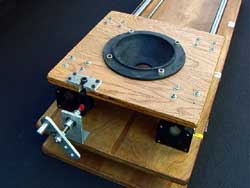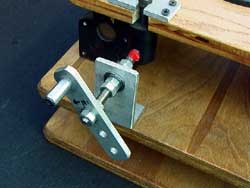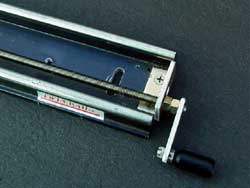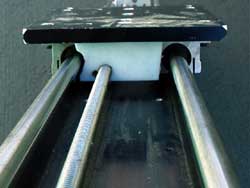Dollies for Stop Motion

|

|
Working with miniature sets requires smaller but very rigid dollies. I had some 1" Thomson linear bearings and case hardened shaft, which I made into a 42" long dolly track. I attached the shafts to a 3" deep 3/4"plywood box to facilitate mounting the track and to provide stiffness. This dolly worked often and I made more dollies using 3/4" linear bearings and shaft I scored as junk. The latest version uses Teflon bearings reamed to 3/4." In the middle of each box is a hole to permit tightening the Dexter High Hat Leveling Ball knobs. For offset dolly moves into a set we sometimes hung the dolly on its side over to one side of the set where the track wouldn't be seen in the shot. The camera was hung on a strong 90-degree angle plate to provide clearance under the camera. The camera looked to the side on one side of frame and straight ahead on the other side of frame just clear of the dolly track. The end frame was a close shot of the puppets under a tree. The camera moved through tree branches to give more feeling of depth to the shot. The branches were removed after clearing the lens. To dolly through a house we mounted the camera to a bar extended off the end of the dolly track that allowed the camera to move straight in over the set. Break-a-way floor was not feasible. The bar was 3/4" by 4" aluminum and rode on a Teflon pad at the end of the dolly track. Aligning the camera on the end of the bar was a challenge.

|

|
We move dollies with 3/8-16 stainless steel threaded rods with cranks on the end and a 3/8" nut. The nut allows a 9/16 "socket in a reversible battery drill to move the camera back and forth quickly. One turn is a 1/16 "animated move.
We also used these dollies to move vehicles for stop motion and to move arms that the puppets were rigged to.
All of these dolly tracks are case hardened steel and are subject to rust and the linear ball bearings subject to dirt like the backing soda that we used for snow. They should be kept clean and lubricated with a gun care cloth. Make sure that no tape is used on the track rails that the bearings are required to roll over. The boxes to support the rails have room for tape and witness marks. If you find some stainless steel "ground round" rails, which are softer than case hardened steel that would be scored by Thompson bearings, you can use Teflon bearings with no problem with rust or getting the bearings dirty.
Smaller 1/2"rails can be used for heavier cameras if supported often. 3/4" and 1" only need to be supported at the ends. These tracks can be bought new, but are quite expensive.
For lighter cameras you might consider ball bearing drawer slides. They come in different qualities. The ones for electronic drawers are better than ones for household drawers. Used aluminum ones might have detents worn in them. Pairs of them are much more stable. Mc Master-Carr has some lower cost dovetail slides that might be rigid enough. They are called "Low Profile Teflon-Lined Plain-Bearing Guide Blocks and Rails." They are reasonably priced; I have not tried them yet.
© Copyright 2004 Ron Dexter. All Rights Reserved.





